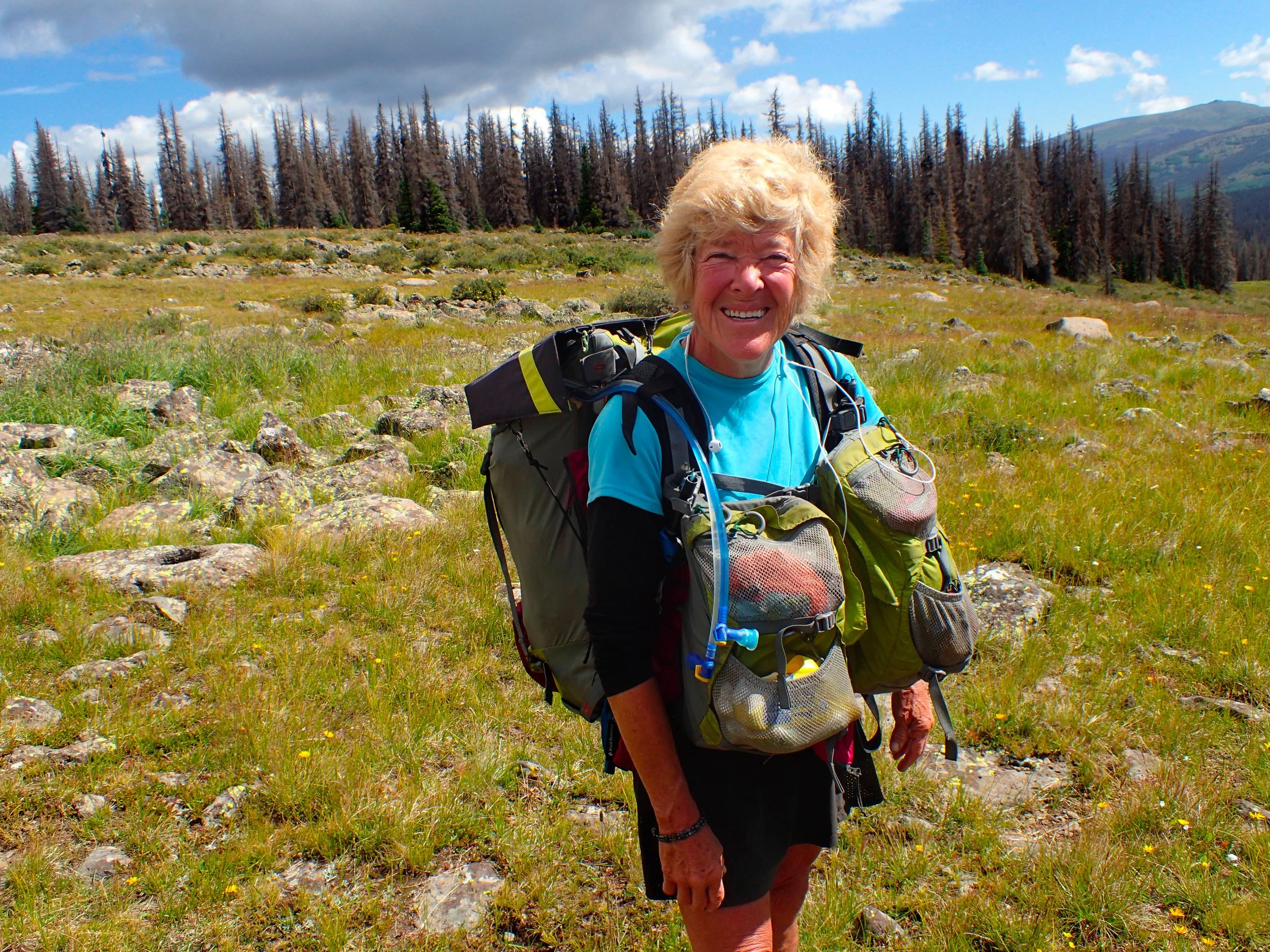No Age Limit: Skiing at 60 and Beyond
Do you ever grow too old to ski? Is it ever too late in life to learn? We spoke with over 15 seasoned pros to find out.
Some members of the 70+Ski Club post for a group photo during one of their trips to Alta Ski Resort in Utah. The club offers members trips to ski areas all over the world.
February 10th, 2025
Home > Learn Outdoor Skills
A few seasons ago I was riding the Red Lady chairlift at Crested Butte and struck up a conversation with the gentleman next to me. He lives in California now, he said, but used to live in Crested Butte back in the ‘70s. He’d skied here when the gondola was running.
The ‘70s? A gondola?
“How old are you? I asked.
“I’m 92.”
92! If the bar on the chair hadn’t been lowered I might have tumbled off.
“How have you managed such a long life skiing?” I asked.
“I’ve been lucky,” he said, dropping his ski tips and scooting off the chair.
That brief conversation piqued my interest about all the oldsters I started seeing around me. Actually there were a lot of wrinkles and gray hair on the nordic trails and tracks and standing in the lift lines. Including me. I’m 72.
What I wondered, besides luck, plays a role in the longevity of a skiing life? What motivates seniors to go out in the snow and cold? What inspires them? How did they get started? How do they train for skiing at an advanced age? What advice on aging and skiing would they give others?
So when the editors of Treeline Review asked me to write this piece, I said I’d be happy to do some research. Through emails, texts, social media sites, and friends, I met a plethora of skiing oldsters who were happy to share their stories.
Meet skiers 60+. They’ll share some stories from their time learning to ski or snowboard, share how they enjoy skiing now, and provide some sage advice.
This story was made possible with a grant from REI.
We create reader-supported, objective, mission-driven gear reviews independently selected by our editors. This story may contain affiliate links, which help fund our website. When you click on the links to purchase gear, we may get a commission – without costing you an extra cent. Thank you for supporting our work and mission of outdoor coverage for every body! Learn more.
Skiing over 60 video
From a recording of our live event with Jesse “Dr.J” Logan, Lisbeth “Hurricane” Carter, and Junior Bounous. Followed by Q&A from the audience of Treeline Review readers.
Meet Skiers over 60
Marty Olavarri
I am a 71 yr old Kirkwood skier. Most days I am the youngest in our group of skiers! I've been skiing for 53 years and have no plans to stop any time soon!
Bob Nail
I turned 74 and have been getting in at least 35 days per season for the past 45 years. An old ski bum at Whistler told me in 1978 that you have one life to live, so live it at a resort!
Jackie Mart
We're 72 years old and still telemark at our local ski area. Also, cross country tours. I’ve been skiing for 50-some years now. Still love the exquisite mountain beauty and being physically active.
Bob Burnell
I'll be 71 in October, and I just renewed my season pass at Stevens Pass again. I can't imagine not skiing.
Linda Weeks
My husband and I still cross country ski in races for the MI Cup in MI. We are 70 and 71, and see skiing as our fountain of youth.
Hung-chee Chan
I am 74 and still ski the so-called “expert slopes,” when the snow is soft.
Steve Liberman
I'm 78. I ski for the same reasons now that I did when I started 40 years ago. I get better every winter, and I skied my best ever last season.
Chuck Chladek
Come to Winter Park Resort and ski with the Ski Meisters. The required age to join the group is 55, but the vast majority of our 400+ members are in their 70s and 80s.
Donna Rutan
I am 67 and have no plans to stop skiing, but to ski more and travel anywhere and everywhere to ski. I am from the Midwest, but love the mountains. It’s so tranquil and relaxing just cruising down the mountain.
Rob Werry
I’m 67 and part of a very small tour company based in Australia that focuses on taking seniors skiing to Canada. Skiing is like a calming music in my mind. It’s addictive. Someone once called this feeling as dancing with the mountain — that sums it up perfectly for me.
Junior Bounous (99)
Junior Bounous at Snowbird on his 96th day of skiing that year, which was on April 26th, 2022. Photo courtesy Ayja Bounous.
“When I go to the top of the mountain and look around it’s the same feeling I’ve had for 70 years,” says Junior Bounous. At age 99, Junior still approaches winter and skiing with childlike wonder, enjoying the views, the trees, the birds, the snow. He skied 89 days last season and would have skied longer, but for an emergency heart procedure in April.
Junior is legendary in the ski world. He is famous for his competition racing and ski jumping, for his involvement in the budding ski industry, and for the development of Snowbird Ski Resort in Utah. What Junior is most famous for, though, is teaching. From 1948, when he became a full-time ski instructor until he retired at age 89, Junior taught thousands of people to ski. He was fundamental in developing the American Ski Technique, which prioritized enjoyment over rigid sequence in ski instruction. Junior also pioneered techniques for skiing powder when he started sanding down the ski tips and tails and bumping the bindings back to increase floatation.
“A big part of why seniors keep skiing is the social part,” Junior says, “It’s the friendships, the community of skiers. A big part of why senior skiers quit skiing as they get older is because they lose their friends, and they don’t like to go to the mountain alone.”
Junior Bounous with his trophy after winning the Wasatch Mountain Club's cross-country race at Brighton in the spring of 1946. Photo courtesy Special Collections, J. Willard Marriott Library, The University of Utah.
When Junior sees older skiers in the lift line he makes it a point to talk to them, see where they’re from, and “spark their feelings about the environment.”
“If I tell them my age, it shocks them, and sometimes I don't tell them. When I'm with family and friends, the first thing they say to them is how old I am, and I don't necessarily like that.”
Would Junior teach a 70-year-old how to ski?
“I would love to take somebody 70 years old and teach them to ski,” Junior says. “But it would also depend on what their background is. Many people at 70 have lost their agility. They haven’t continued in life with anything to maintain this. The thing about skiing is reacting to the feel of movement. It takes agility, balance, and body and eye coordination.”
Selection of terrain is also important, said Junior. “As I've gotten older I've slowed down. I ski more intermediate terrain. I take my time and enjoy the mountain. I go out and ski in the morning and go home at noon and take a nap.”
Which might make you think Junior is a slow old guy.
“He skis fast,” says his 33-year-old granddaughter Ayja, herself an accomplished skier. “Once he pushes off, you can’t catch him.”
Junior has had numerous challenges in his life, says Ayja. Prostate cancer. A near-fatal staph infection. “After Grandma died, it was like his heart stopped functioning. He went into a severe depression. He was dying from a broken heart.” This past April, his aortic valve had to be replaced.
Through it all, Junior has managed to get back on his feet — and back on his skis.
“Junior is the poster child of skiing into your old age,” says Ayja.
For anyone interested in learning more about Junior’s life and the American West ski industry, Ayja has written an award-winning biography, available here.
Lisbeth “Hurricane” Carter (74)
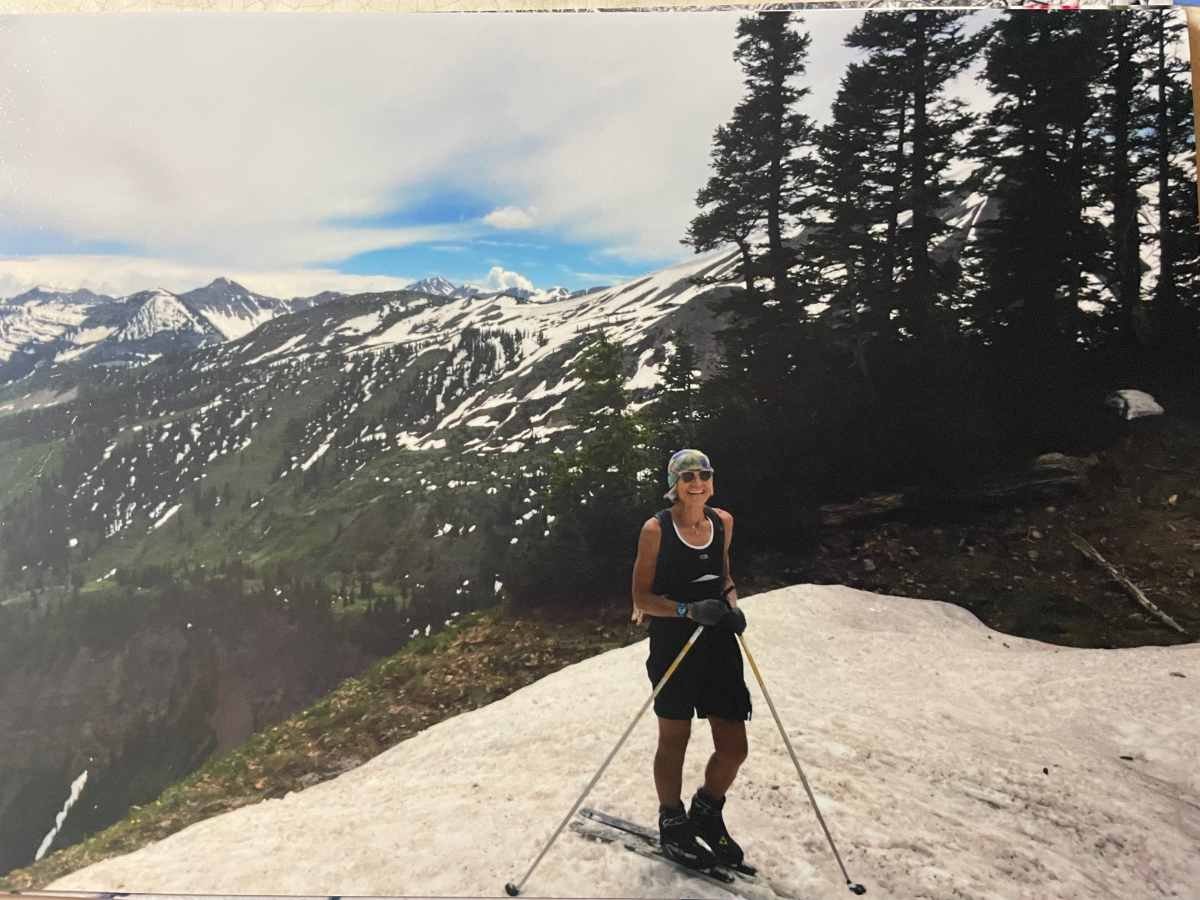

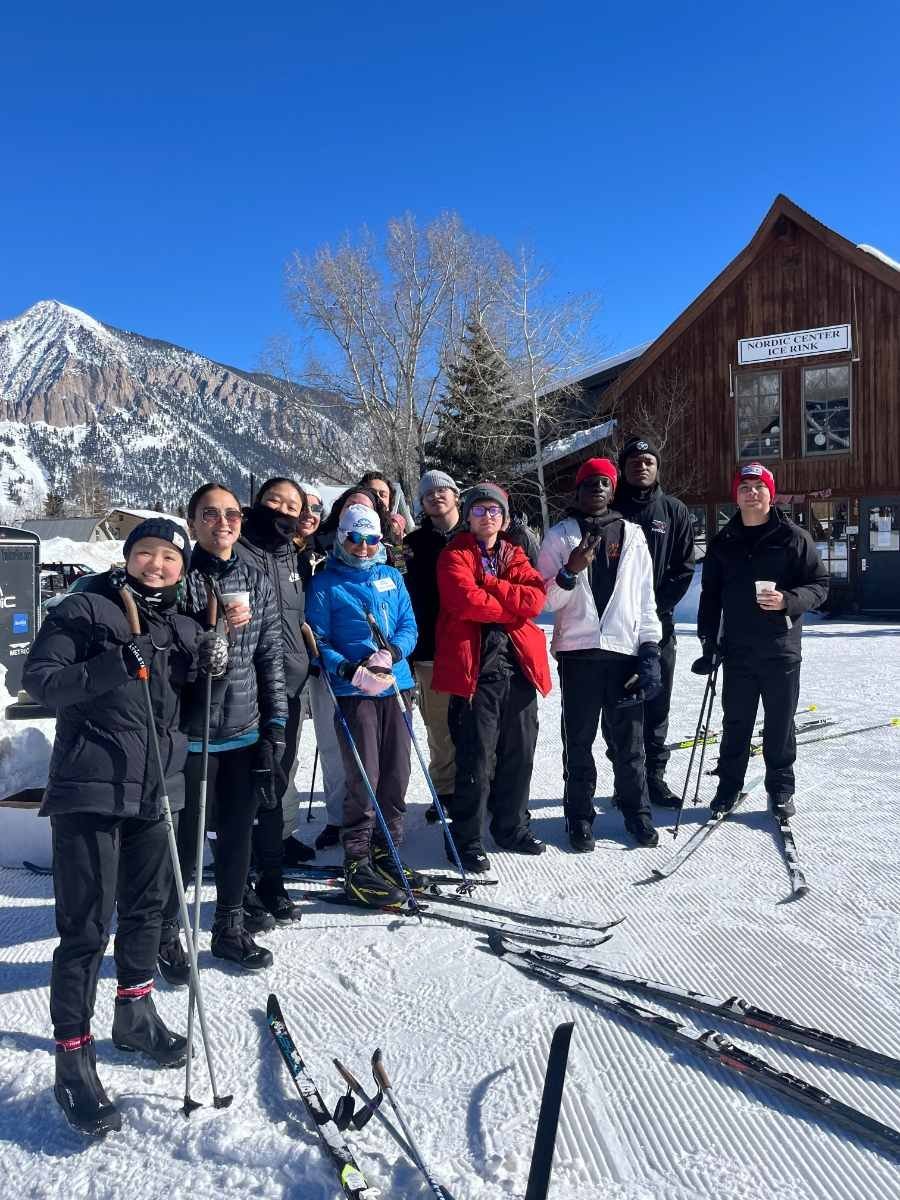

“I don’t care if somebody calls me senior. Why would I care? What can I do about it? I don’t care. Get over yourself,” she says. “On my birthday every year I ski my age in kilometers, and this year that’ll be 74.”
Lisbeth "Hurricane" Carter in her favorite backcount place near Crested Butte, Colorado. Photo courtesy Hurricane Carter.
Hurricane started skiing when she was 40 years old and living in Boulder, Colorado. When the front range scene “got too big and crazy” she moved to Crested Butte, Colo.
For 14 years, Hurricane taught alpine skiing at Mount Crested Butte Resort. And then one afternoon an out-of-control skier hit her while she was teaching, and she was forced to quit. Hurricane spent years in rehabilitation. “I’m part plastic, part rebar,” she jokes. “I never got back on my alpine skis. I don't like being around that kind of hubbub anymore.”
Now she’s completely nordic. “I like being in the backcountry and on our trails. Nordic skiing is so much fun. Especially skate skiing. You can go so fast.”
Hurricane stresses that the important thing about skiing when you’re older is to keep moving. During the winter she is diligent about skiing every day. “I would ski on one flake of snow if I could,” she says. During the summer she runs every day and she is diligent about that, too.
“I do something every day, so I don't have to break myself in,” she says. “Consistency is the foundation of staying in shape because you enter older age and not having to tell yourself that you have to get fit.”
“A lot of people become interested in Nordic skiing because they had a bad experience on alpine skis,” she says. “There's so much more you have to know to get on a ski lift and come down. At the Nordic Center there are gentle slopes to practice on and by the end of the first lesson a lot of people can come down the hill.
“In Nordic skiing beginners can get confident scooting around on the flats. When you’re beginning, the best thing is to find a community of people to ski with. That’s a great way to learn. When you’re with a group of skiers, like the Gray Hares here in Crested Butte, you can learn to get comfortable on your skis without having private lessons. And you’re skiing with people who understand what it’s like to ski in their older years.
“The key to learning to ski as people age is terrain. If you're 80 years old and you're a little stiff, start on flat terrain. You can scoot around a flat track all day. It gives you companionship. People are passing you and saying hi. You're just out there you’re not hiding from everybody. It doesn’t matter if you’re not going fast. You can have the most rickety pair of skis and just put them on and go out there.”
As the new coordinator of the Los Inmigrantes Unidos Outreach Program (the United Immigrants), Hurricane wants to work with a broader community of skiers. During the past few winters, Hurricane has been teaching the Cora people how to ski. Originally from north central Mexico, they have made their home in the Gunnison Valley in Colorado. Hurricane teaches Cora children, fathers, mothers, grandmothers, and grandfathers. “I love it, and they love it.”
“At the Nordic center and out on the ski trails, I have never seen anybody express one bit of prejudice. They are walking into another family, a ski family, another community. We may have our language barriers — the Coras have their own language — but skiing breaches all barriers.”
Jesse Logan “Dr. J” (80)
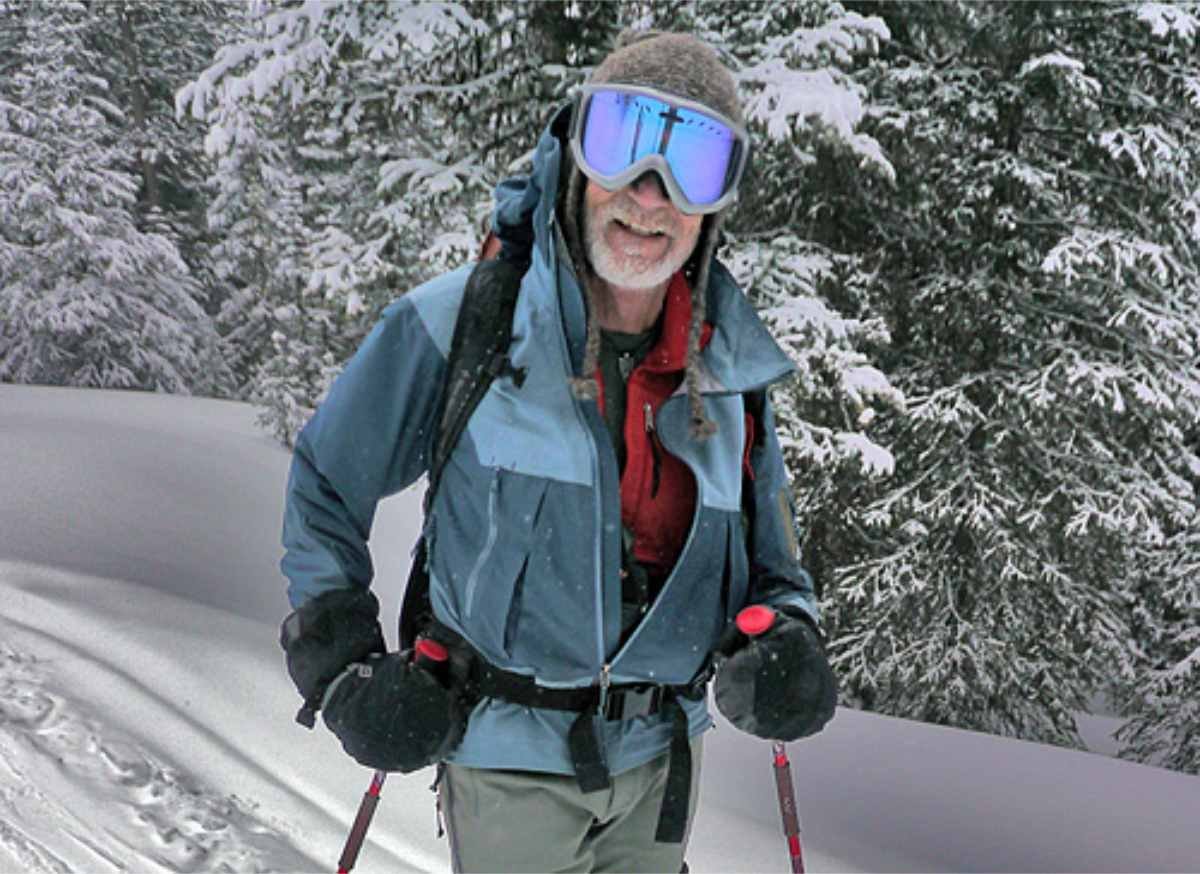
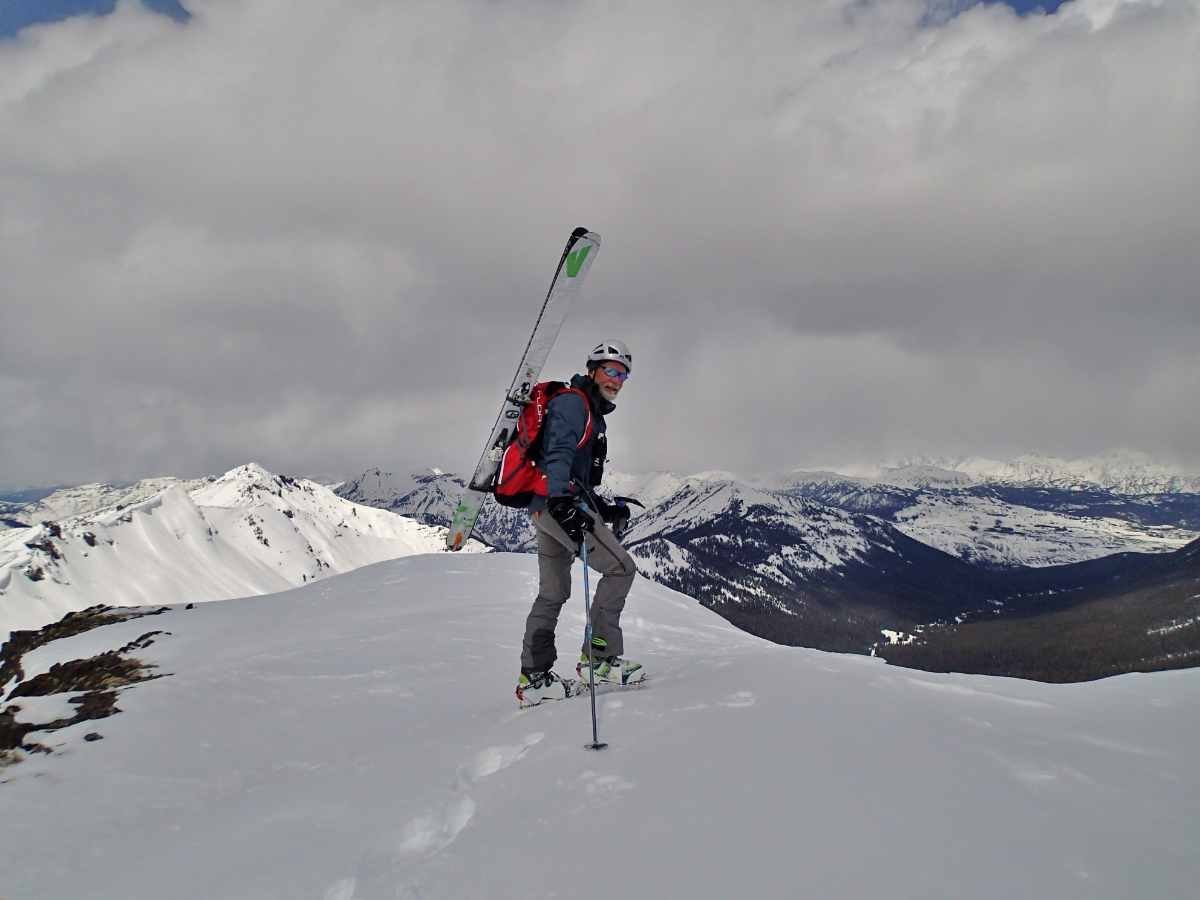
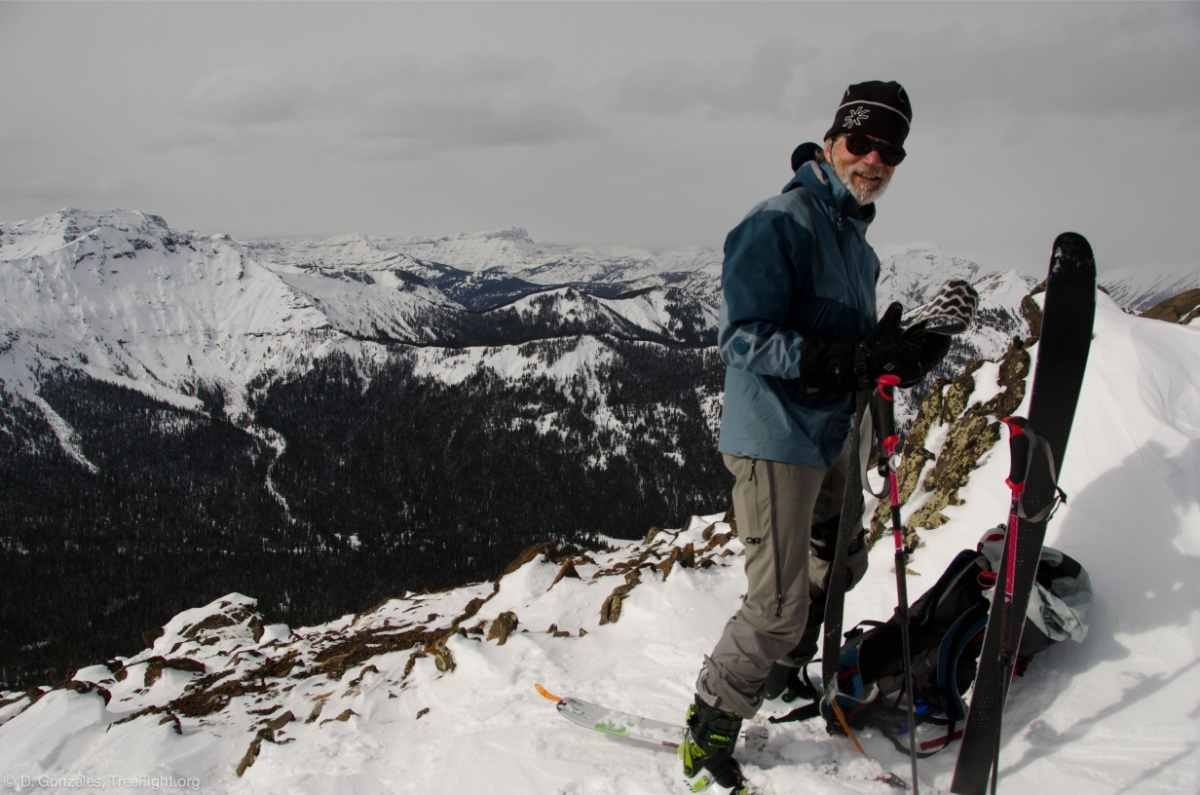
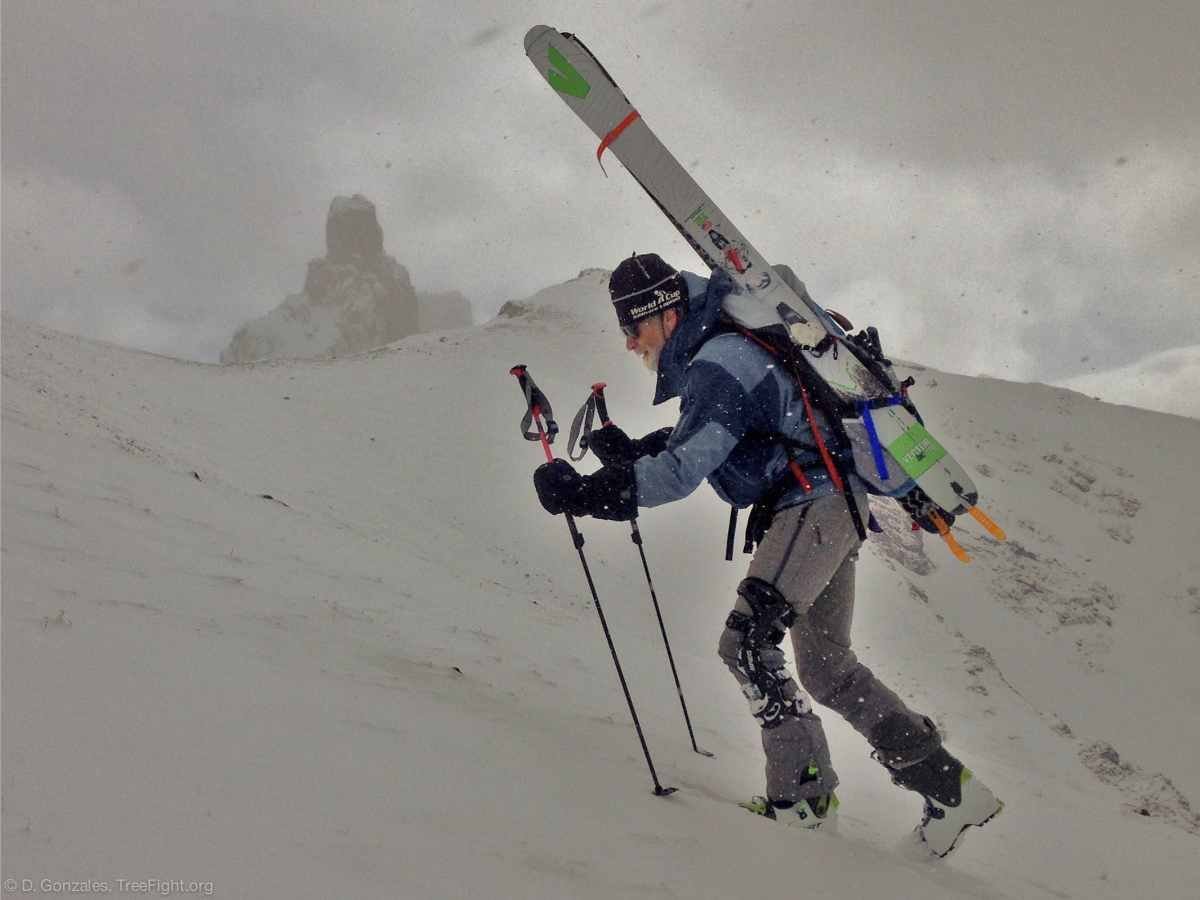

Yellowstone National Park backcountry ski guide Jesse Logan (Dr. J) skinning up a steep slope before skiing down in the backcountry of Yellowstone. Photo by Beau Fredlund, photo courtesy Jesse Logan.
“Our society tends to discount and devalue older citizens. There’s some sense of us against them, older generations against younger generations,” says Dr. J. “Backcountry skiing bridges all that. The friends I ski with have great respect for young people. They deeply care about what’s going on. Skiing with young people, the 30 and 40 year olds, keeps you going as an older person. And at 80, I’m still going.”
Dr. J spends over 100 days skiing the Yellowstone backcountry every winter. This is his 14th year as a guide, having first worked 10 years for Beartooth Powder Guides, and more recently for Yellowstone Ski Tours.
“What I offer is how to safely travel in the winter backcountry, along with a broader experience of the high mountain culture, ecology, and wildlife. On a fresh day we sometimes cut across wolf tracks. Where else can you experience that?”
Dr. J really didn’t start skiing until he was 40 years old. Even as a novice his first love was the backcountry. When he retired as a researcher for the Forest Service in Utah, he and his wife moved to Cooke City, Montana near Yellowstone National Park's northeast entrance.
“The common thing you need to realize is that there is an aging process,” Dr.J says. “It’s an important mental adjustment. Finding the zone where you can push yourself physically and mentally but knowing that you have limitations. Being realistic of where you are, and what you can do. You’re capable of doing more than you think you can. But you also don’t want to be someone else's problem.”
Dr. J carries a Garmin inReach so that he can check in while he’s in the backcountry, and get weather and avalanche conditions. “But I mainly have it because of my wife. I call it a relationship saver. It’s a valuable tool, but not one you want to completely rely on.”
“I find backcountry skiing tremendously rich,” Dr. J says. “I like the snow and cold, the challenges, and pushing myself physically. It’s also enriching because I have a partner that enjoys it. I can hardly wait for winter!”
Randi and Terry Young, (72 and 85)
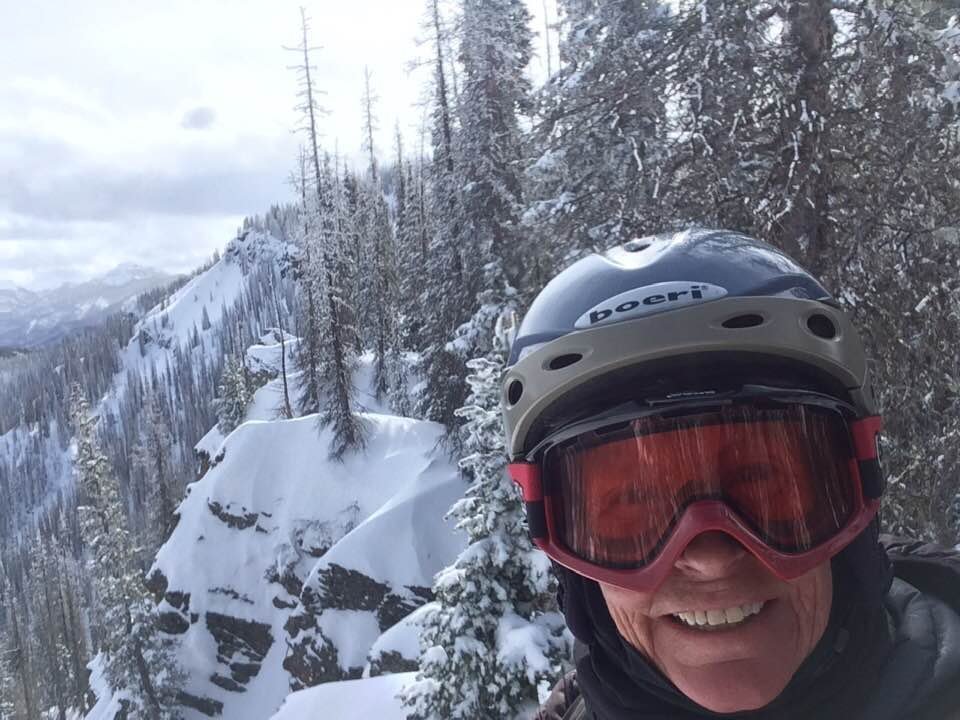

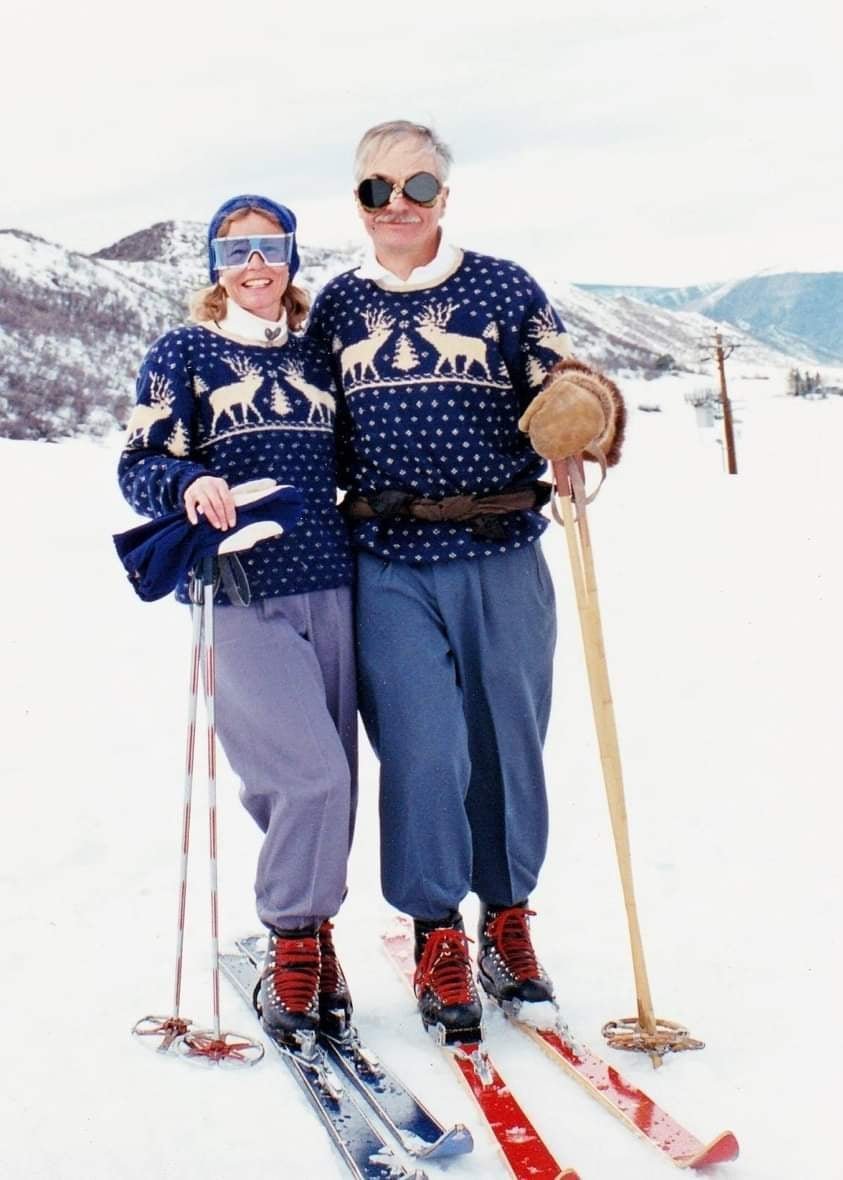
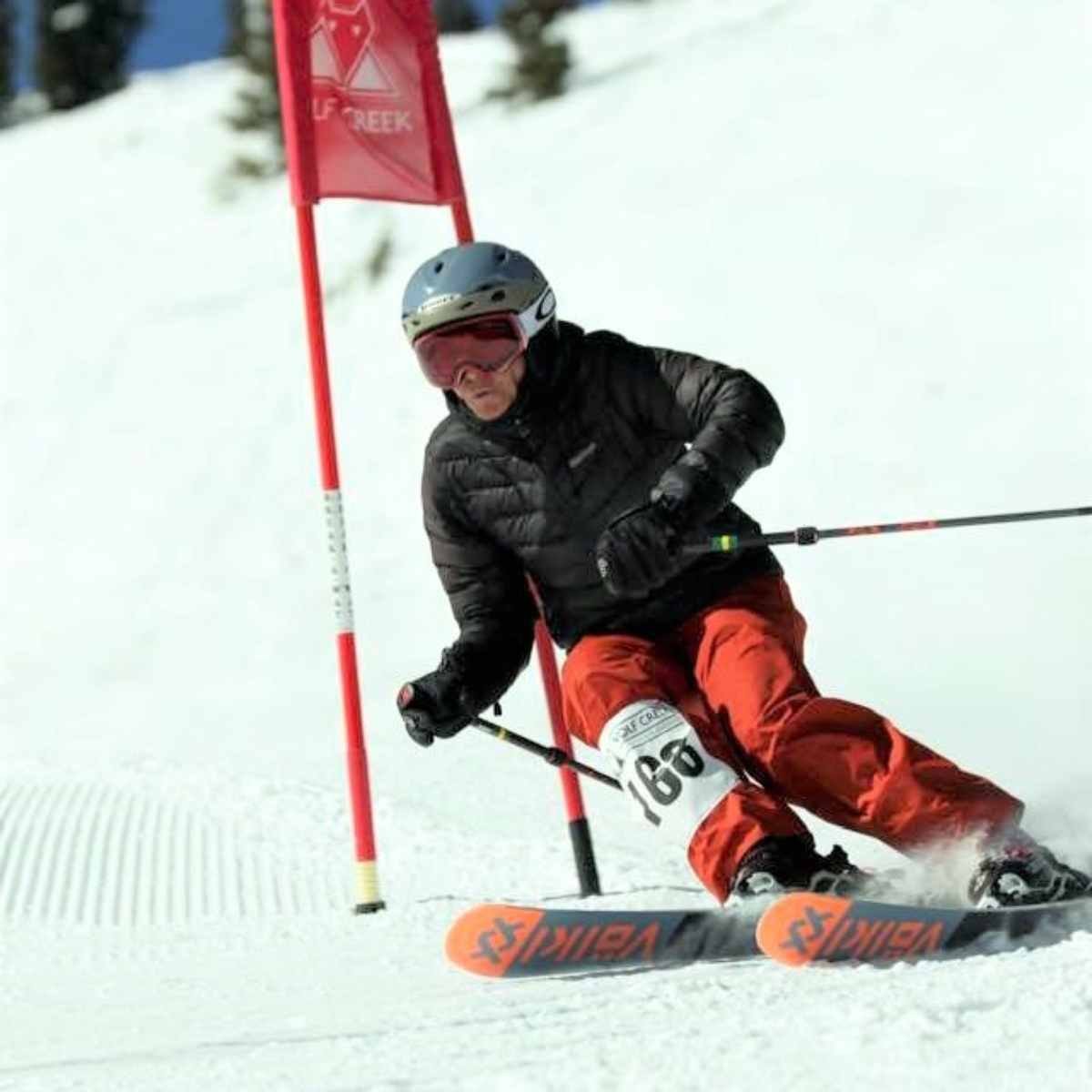
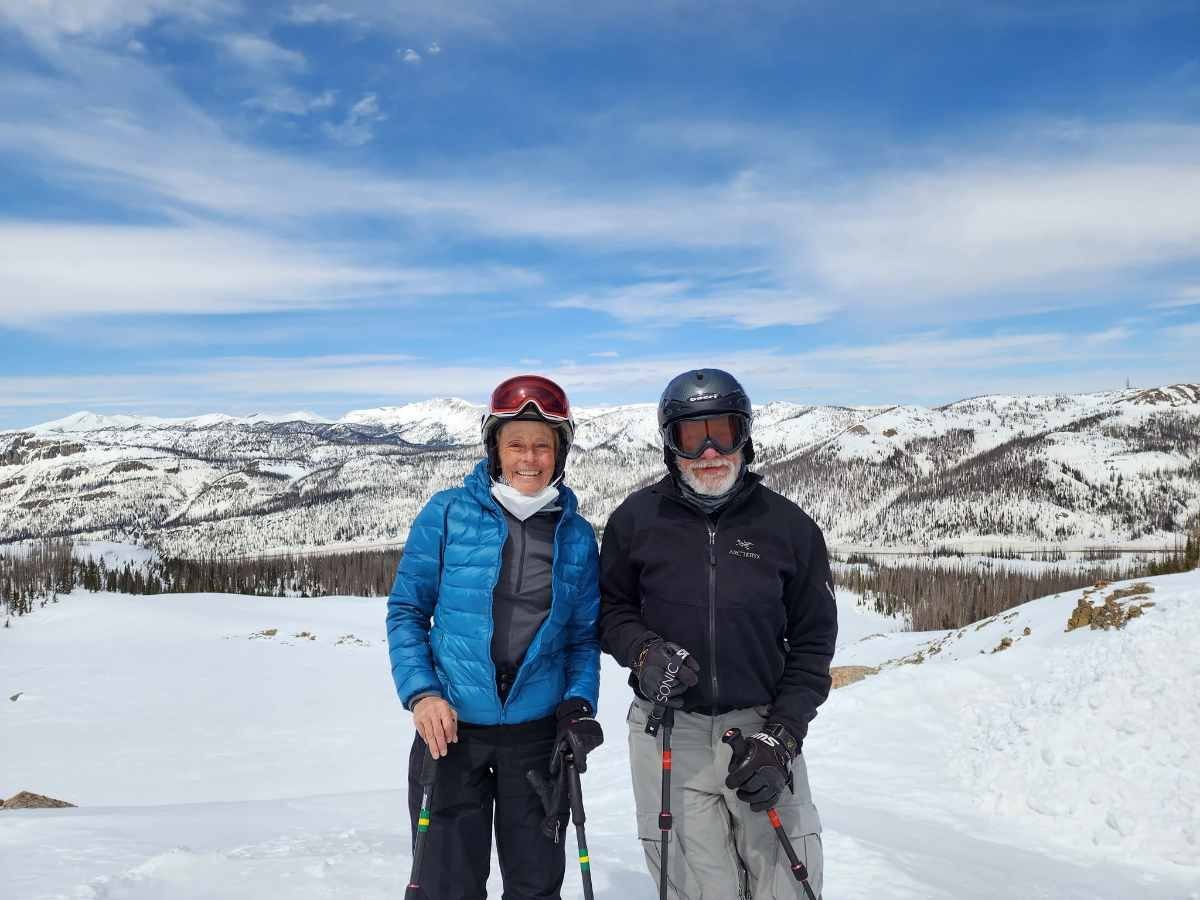
Randi Young in her happy place, Wolf Creek ski area on Wolf Creek Pass, Colorado. Photo courtesy Randi Young.
“At some point skiing becomes so natural it almost feels as if my skis and boots have ceased to exist. I’m floating, just sensing the snow, feeling its texture,” says Randi Young.
Randi began skiing in 1976, at age 23 when she moved to Aspen. She bought a $5 pair of boots, got some skis at a ski swap, and found a pair of used, mismatched poles. That first day she followed anybody who looked like they knew what they were doing. That spring she skied four days before the lifts closed. “I was absolutely hooked.”
“Skiing came to me pretty quickly,” Randi says. “I started racing when I was 42. In my first race at the USSA Masters National Championships, I won a silver medal in the slalom and a gold in the giant slalom and downhill combined.”
Randi usually skis over a hundred days each season, still races,and still wins medals — at age 72. Her greatest race though has been against cancer. In June 2021 she was diagnosed with stage 4 lung cancer and the cancer had also spread to her brain.
Despite long periods of radiation treatment for her brain and the removal of part of a lung, Randi was still able to put in some ski time. During the 2022/23 season she skied 30 days.
“It’s very difficult to go long distances on the mountain,” she says. “But skiing is my greatest freedom. Skiing I’m able to rekindle my sense of power and for a cancer survivor that’s a pretty huge thing. It's the one thing that brings me joy.”
As for skiing when a person’s older. “My mom started skiing at 55 and skied for 20 years,” Randi says. “For older people it depends on their physical conditioning. You have to have some physical prowess. I don't do a ski conditioning class but when I’m hiking I make it a point to do a lot of lateral footwork, like football players.
“One of the big things for people over 50 is joining a seniors ski club and finding other people to ski with. There’s camaraderie. Almost all ski areas have a club for seniors. At Wolf Creek we have the Grey Wolves.”
Ski clubs aren’t for Randi however. “I don’t really want to be with people. I just want to just fly.”
Randi’s lifelong partner and soulmate, Terry, also skis.
Unlike Randi, Terry follows a strict regime of stretching 30 minutes every morning. He rides a stationary bike on a Mag trainer for 40 minutes and last winter, in addition to skiing at Wolf Creek ski area he cross country skied 100 miles.
“In some respects I feel like I'm in my 20s when I'm out skiing,” Terry, 85, says. “In spite of that, when I turned 83 I could feel that I was slowing down. That I’m getting older. There’s a bit of a memory thing too. I’m not as sharp as I was. When I hike up to the knife ridge I can't keep up with Randi. She's in shape. But it doesn’t bother me. I let her go.”
When it comes to longevity in skiing Terry believes it comes down to lifestyle. “You have to watch what you eat. You can’t eat junk food. You have to exercise. The important thing is to walk. Walking is going to help.”
Skiing has been a lifelong involvement for Terry. He’s designed skis, made skis, sold them, traveled to Europe to represent skiing companies and tested skis. But his love is tuning skis, for which he became nationally famous.
“I enjoy working on skis, it’s the love of my life and I just get lost in it. You have to have the skis tuned and waxed properly. They go together. They go hand in hand. What I really enjoy doing is prepping Randi’s skis for races and getting her to the point where she’s the fastest.”
Greg Vautour, 71 years old
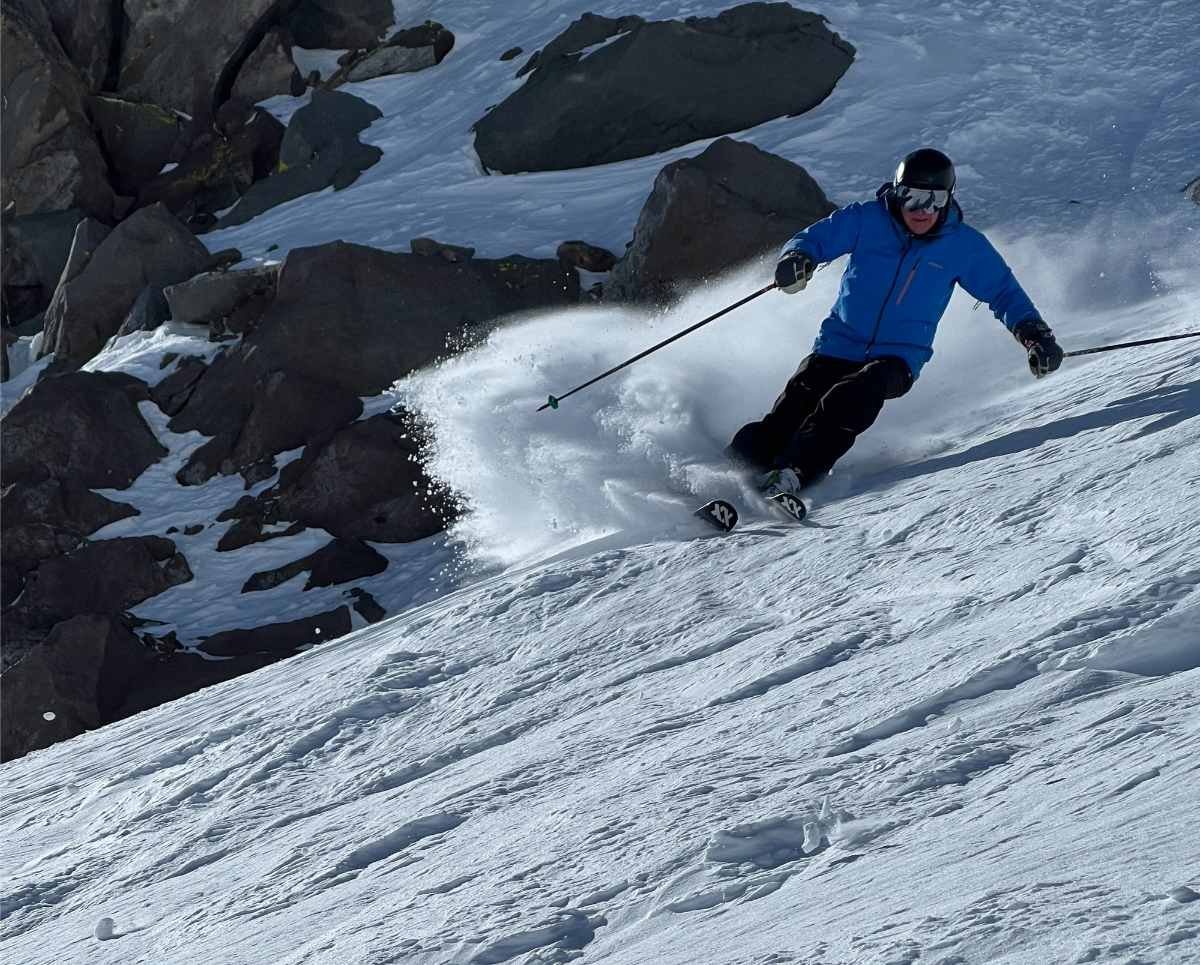
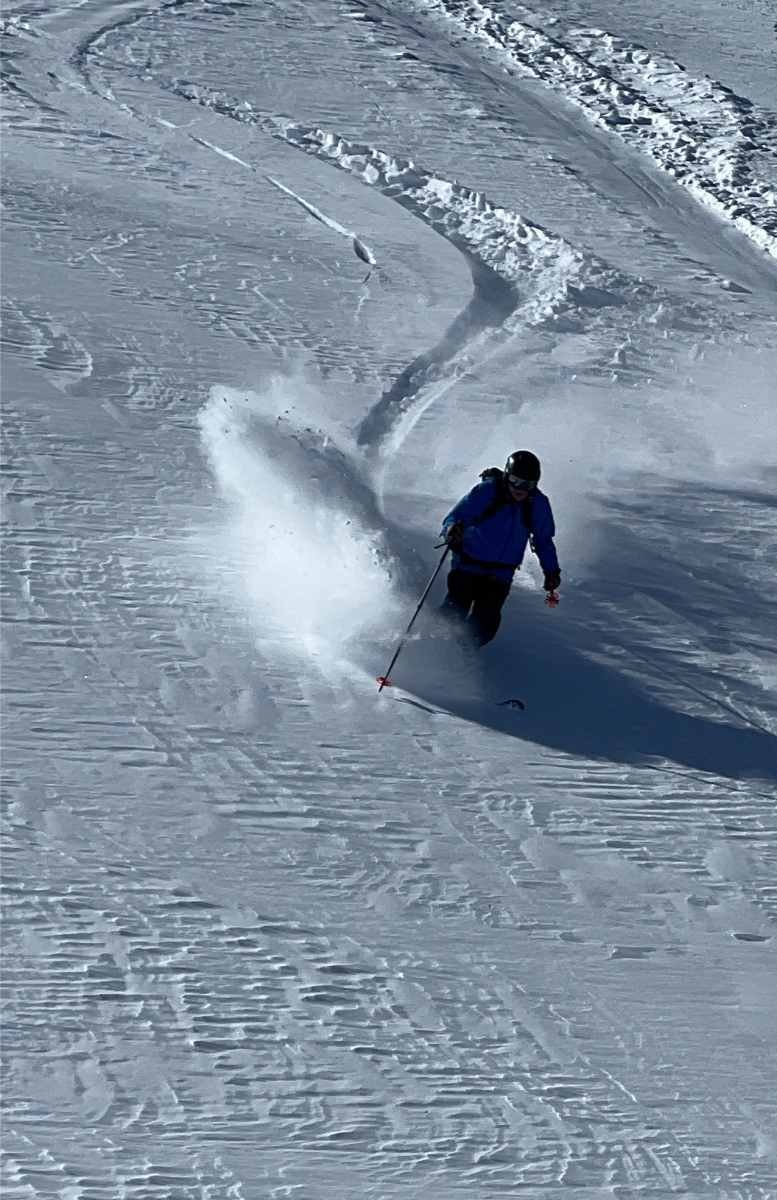
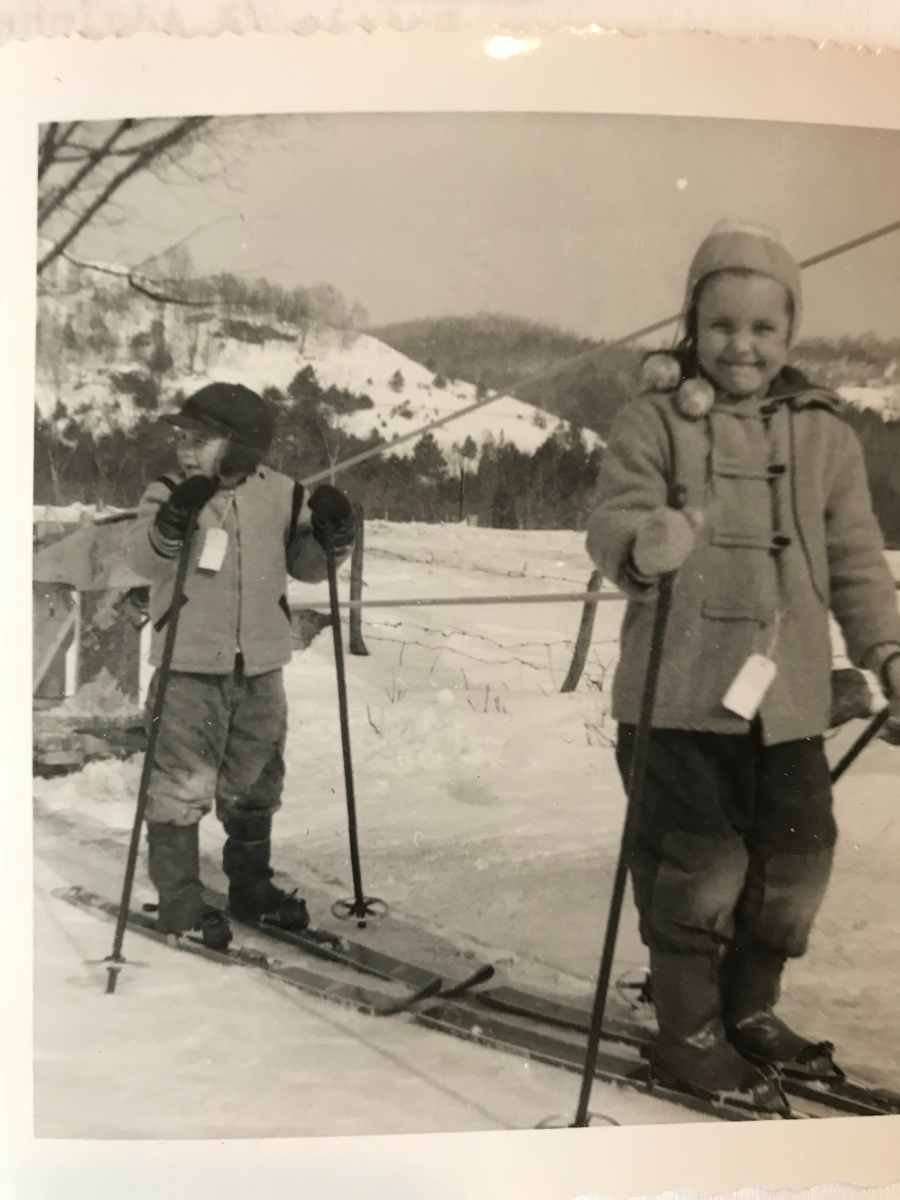
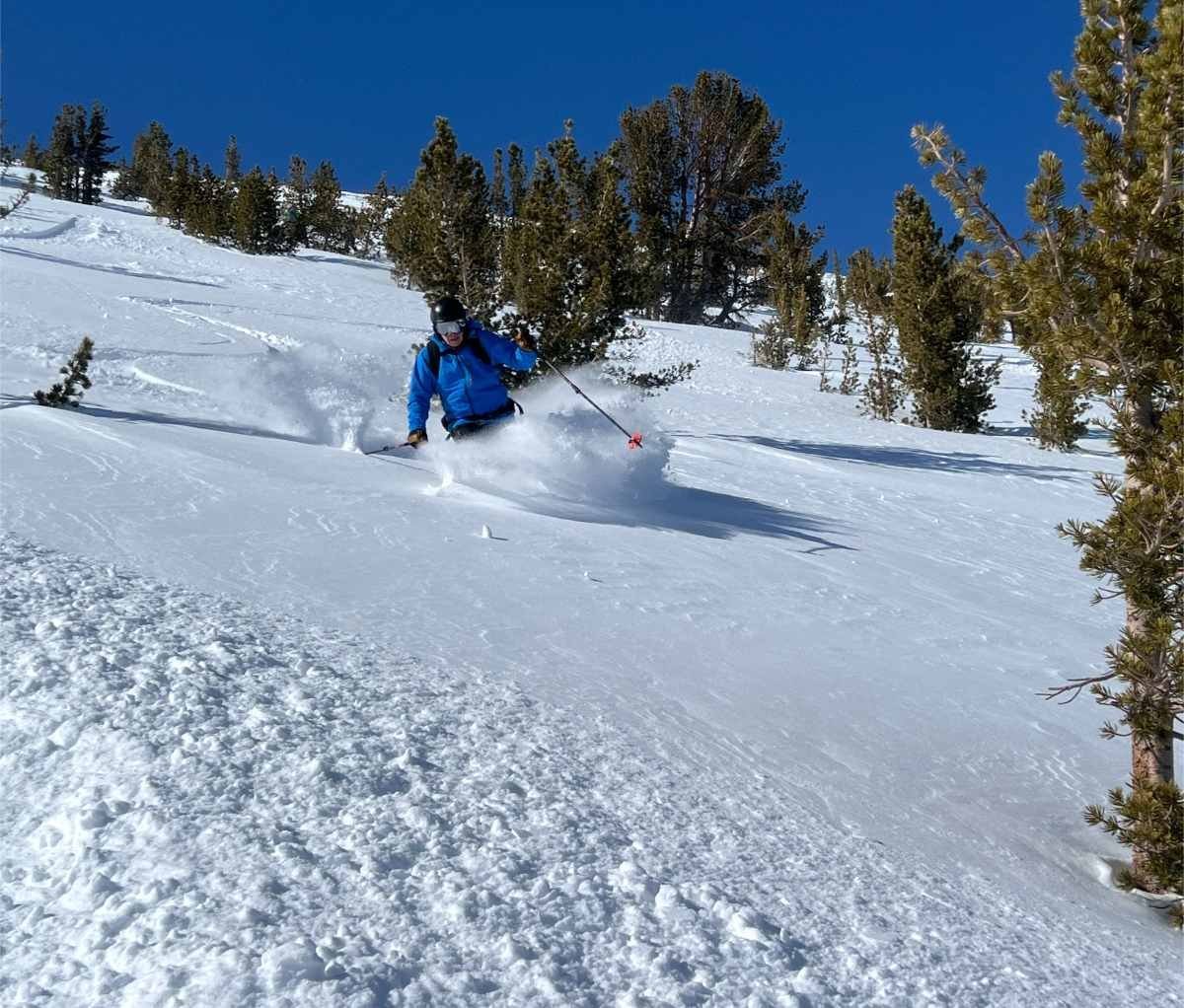
Greg grew up in Vermont and learned to ski at Smugglers Notch Ski Resort when he was just 4 or 5 years old. “My dad was a skier. He loved it and got the whole family involved. He was on the University of New Hampshire ski team and competed in the Ski Meister, downhill, cross country, ski jumping, slalom and giant slalom. He won more points than anyone, before or since.”
After graduating from college, Greg visited Mammoth Ski Area in California. “I took one look and thought well, this could work. There was sun. Vermont can be very cloudy, gray and depressing. I didn’t see a cloud the whole time I was there, and the sheer size of the mountain was very alluring.”
“I became a bicoastal guy after that,” he says, spending time in Vermont and California. In 1990 he decided, “Life's too short. I’m going back to Mammoth.” He was an instructor there until he retired in 2020.
“I’ve cross-country skied all my life as well,” he says. “I also backcountry ski, although not as much in the last couple of years. I have done some pretty radical stuff in my day. I put together a team that went to Europe and competed in a 7-day backcountry ski race through the Alps that was written up in Outside Magazine. I’ve learned to temper my desire somewhat. Now I defer to caution.”
Greg doesn’t believe people ever get too old to ski. He’s 71. “My dad skied until he was 89 and he’s still alive and kicking at 96. As long as your body is capable, you can ski into your 80s and 90s. I taught a lot of older people. But it’s important to have some basis in physicality before you start. That goes with anything: you just don't go out and do it.
“It’s beneficial to take lessons. The best athletes in the world all have coaches. And do not use other people’s equipment. Skis are personal to you. Now rentals have demos and things that you can really personalize, boots, wide skis and narrow skis.
“The thing I have enjoyed most about a lifetime of skiing is the relationships I have formed through meeting people. Many of my closest dearest friendships I’ve developed through skiing. Skiing has made my life great.”
Ginny Peck is a 79-year old snowboarder in the White Mountains of New Hampshire. Photo courtesy Ginny Peck
Ginny Peck, 79 years old
“I didn’t ski until I was 47 years old,” says Ginny Peck. “There was a free lesson at Sunday River in Maine and a friend invited me. After 3 hours I was hooked.”
Peck, 79, lives in the White Mountains of New Hampshire and does most of her snowboarding at Loon Mountain in Lincoln. An accomplished athlete, Peck is an ice water swimmer. She’s competed in events that require swimming up to 100 meters in 31- degree water and is training for a championship event in Italy in January, where she’ll swim 250 meters in water with a temperature under 41 degrees.
She was just finishing up being in a competitive age group of triathletes and “wanted to stop the never-ending training mentality” and do something different, when she discovered skiing. After skiing for a few years she found that she was confident and fast, but not technically-savvy.
“I saw all the young boys riding snowboards and I wondered if I could do that. That thought is always a beginning for me.” Once again Peck took advantage of a free lesson, this time for snowboarding. “Very painful, but once I got it I was hooked.”
Peck found that the difference between skiing and snowboarding was that when she’d skied she was evaluating every single run, but with snowboarding, she didn’t take herself as seriously. “I found it very playful. Of course, I was surrounded by what seemed to be all teen boys. My riding was fast and competent, but not reckless. I did participate in a few Oakley camps where I was able to try boxes and rails.”
Ginny Peck learned to snowboard at age 47 and started to teach snowboarding at age 61. Photo courtesy Ginny Peck.
Peck was confident enough and good enough that at age 61 she went on to teach snowboarding for a dozen years, mainly to adults. “They couldn’t pull the age card on me.” Later she taught the new incoming snowboard instructors.
“Obviously I don’t think a person can be too old to learn to ski or ride a snowboard. My husband started skiing at 52 and is still skiing at 84.”
But because of knee replacement surgeries she hasn’t been on her board since 2021. “So I guess I was 76 when I last rode.”
The knee replacements weren’t from snowboarding, she stresses, but “lots of running miles over the years and some of the inevitable arthritis.” The only snowboarding accident she’s had was a broken wrist at age 59 when she fell while riding in the woods.“No more woods for me!”
Swimming is Peck’s sport of choice for year-round training. She also does stand up paddleboarding to get in shape for riding because it helps with balance, core, and leg strength. “I think that using the SUP is what keeps me in shape for riding.”
Richard Murphy (75)
Richard Murphy on the trail in the Chugach Mountains near Anchorage, Alaska. Photo courtesy Richard Murphy.
Richard Murphy’s favorite thing about skiing is “being completely absorbed in a physical activity where I can't think about anything else.” It’s total absorption. “I don’t listen to music. I am totally into skiing. You have to give skiing full attention. Outside of being a monk, I don’t know where else you can find that kind of active mindfulness.”
Murphy has been skiing for 70 years. He is 75. “I don't remember when I first strapped on skis, but like everybody in New England I learned to ski on a golf course with a rope tow, which was more dangerous than any of the skiing down.”
A trip to New Mexico and a dishwashing job, “set the course of my life,” he says. “I’d never skied powder so when I got to New Mexico I couldn't believe it. My memory of that winter was that the sun was out every day and it snowed every night. Fresh powder snow all the time. I said I’d never ski that New England stuff again and I haven't.”
Later he lived in Jackson, Wyoming and spent the winters skiing in the Teton backcountry off of Teton Pass… “long before it is that THING that it is now,” he commented.
“The closest I ever came to death in an avalanche was on the pass.”
Other than that it was mostly in bounds at Teton Village. Back in the day they had actual Teton County Sheriffs with guns enforcing out-of-bounds restrictions.
“Back then there wasn’t a 3-tram wait for the gondola, or reservations for the rich people."
Richard Murphy on the trail during a cold day in the Chugach Mountains near Anchorage, Alaska. Photo courtesy Richard Murphy.
Now Murphy calls Anchorage, Alaska home. “Mt. Alyeska (Alaska’s only ski area) is closer to New England as far as the quality of skiing,” Murphy says. “Anchorage is at sea level. We have sea fog and rain. The snow here is heavier. We ski on packed snow, not powder.
“Groomer skiing is still skiing and it’s still fun, but I don’t close the lifts anymore and I don’t have that many runs in me. I accept the fact that I can't ski like I once did.”
Murphy spends most of the Alaskan winter in the backcountry. He can access the Chugach Mountains from his back porch. “You have a sense in the Rockies of being in the wild. But in Alaska you are in the wild. Alaska is a meaner, nastier environment. The snow is rattier and the environment is more extreme.
“I like the thrill of skiing but I no longer need that adrenaline push that I once needed. Sometimes I have a hard time with the age thing, but mostly I don’t.
“I like being on trails in the backcountry. If I need a workout I’ll go ski on a groomed track. Cross country skiing is what you do to practice for real skiing.”
The second thing Murphy likes best about skiing? Feeling the sun on his face.
Where to find community (and senior ski pass discounts)
Some members of the 70+Ski Club post for a group photo during one of their trips to Alta Ski Resort in Utah. The club offers members trips to ski areas all over the world. Photo courtesy 70+Ski Club.
A vibrant, active, and healthy community of senior skiers exists, with many skiers over 60 years of age but many over 70, 80, and 90 as well. A few skiers continue on the slopes past 100 years of age. According to the National Ski Areas Association, more than 1.25 million people 55 years old (youngsters) and older ski and snowboard.
The resources available for senior skiers seem boundless. Nearly every ski resort and ski town has a community or club of senior skiers offering companionship of like-minded individuals both for alpine and cross-country skiers.
In Colorado, there’s the Gray Wolf Ski Club at Wolf Creek ski area, the Gray Hares in Crested Butte, and the Skimeisters at Winter Park. Alta Ski Area in Utah also has The Wild Old Bunch, just to name a few.
The Over the Hill Gang International is a 6,000-member-strong organization for senior skiers worldwide, with local chapters throughout ski country.
The National Ski Patrol also has a Senior Ski Patrol division, which offers education as well as opportunities for older skiers to volunteer and patrol the slopes, often with discounted ski passes. The Golden Ski and the Silver Ski Clubs offer organized trips to ski areas, activities (even beyond skiing), and have local chapters that members can join. There is also the National Brotherhood of Skiers https://www.nbs.org/ and Latino Outdoors https://latinooutdoors.org/.
Senior skiers even have a national online magazine and a 3,000-member-strong 70+Ski Club with a seasonal newsletter.
In addition, many ski areas offer discounted senior and super senior daily and season passes. For instance, my super senior season pass at Monarch Ski Area in Colorado costs $25, a steep discount that’s not available at all ski areas. An Epic Local Senior Ski Pass at Mt. Crested Butte is $511. Not cheap, though it’s still less expensive than the regular $778 local season pass.
Alta ski area offers 80+-year-olds free skiing, which bucks a trend at Colorado ski areas to end free skiing for the super, super seniors. Telluride ski area ended its free skiing for 80-year-olds this year, citing the rising costs of operations.
Vail Resorts Epic Pass, costing $1,025, doesn’t give seniors a discount at all, and neither does the Ikon Pass, which is $1,359 for the 2024-25 season.
What’s unsaid is that with people living longer, a larger part of the skiing population is now over 70 years of age, and resorts can’t afford to lose that economic piece of the pie.
A great resource for finding free or discounted senior lift tickets and season passes is Seniors Skiing, which lists 112 ski areas in the United States that cater to senior skiers.
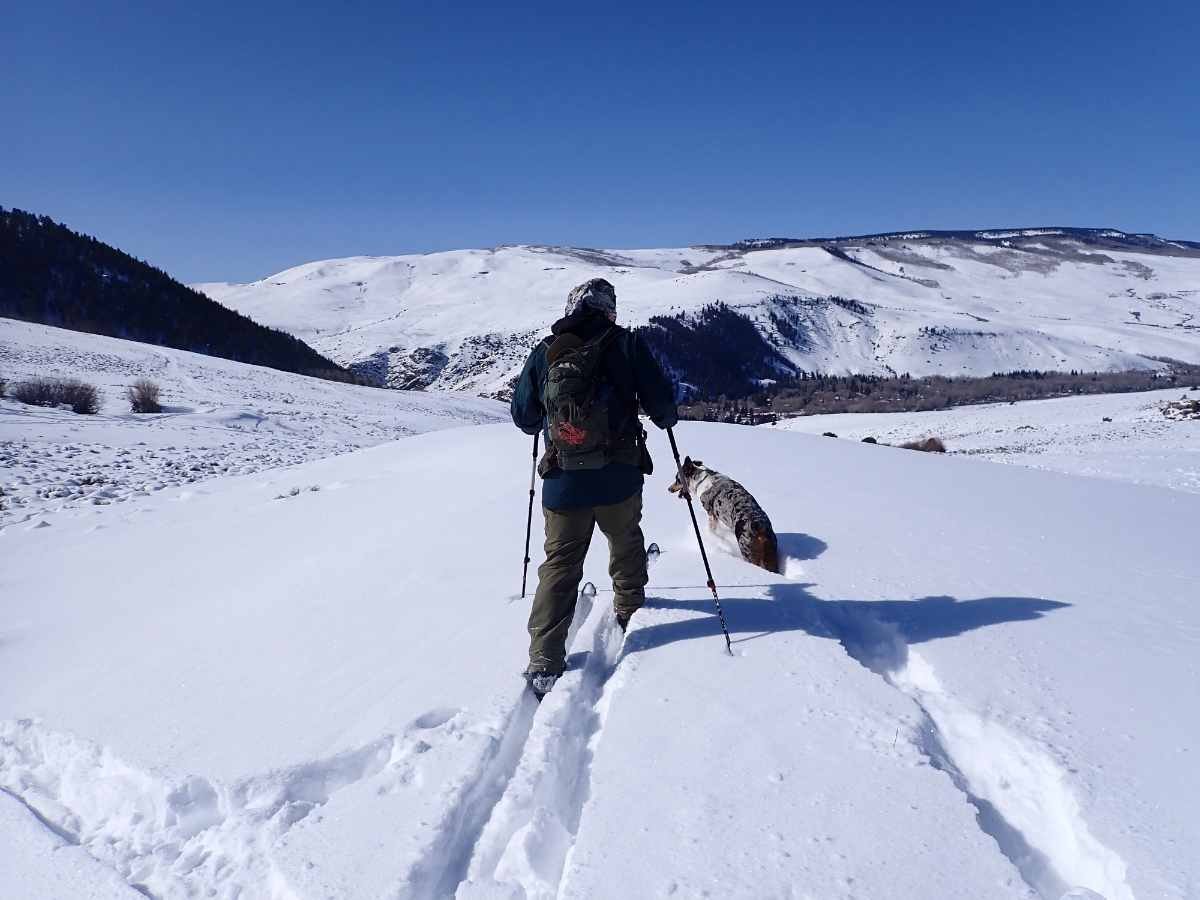

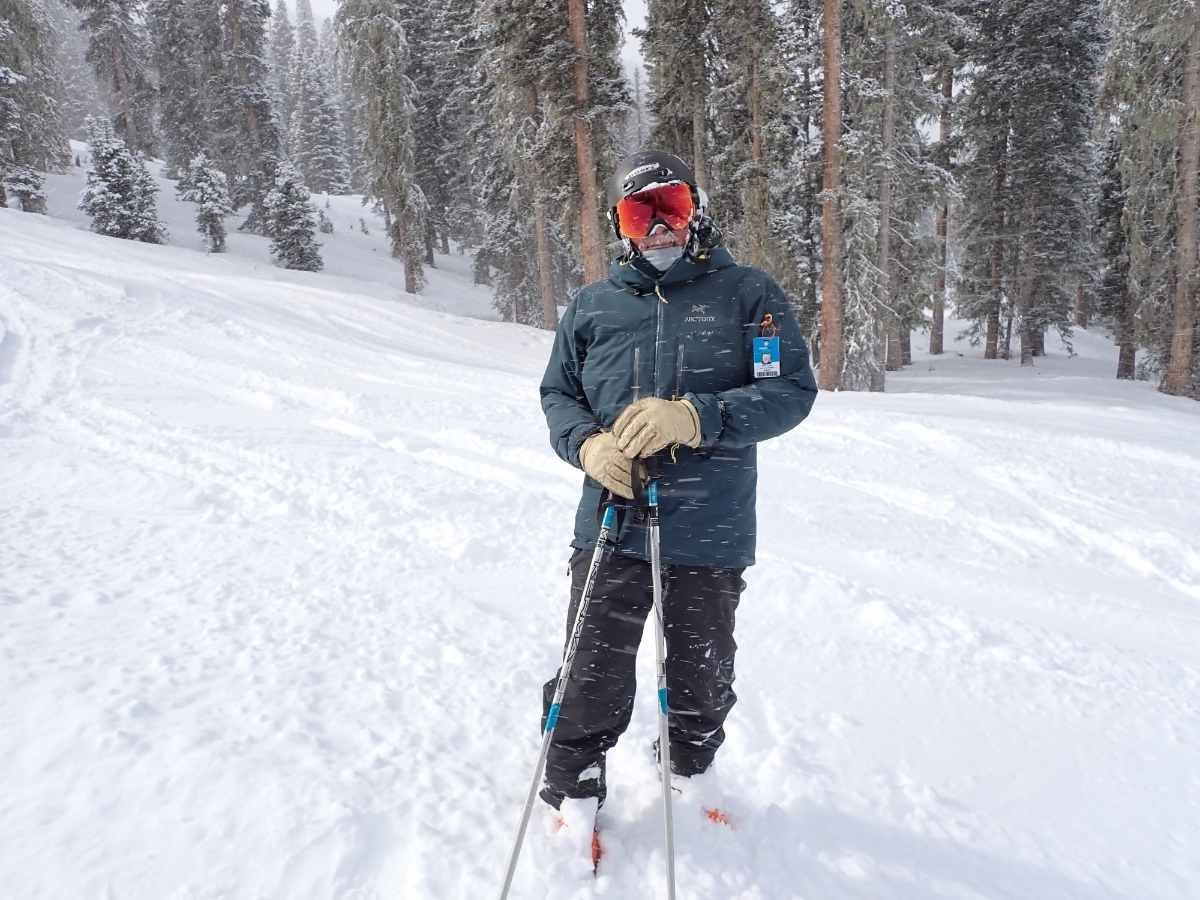
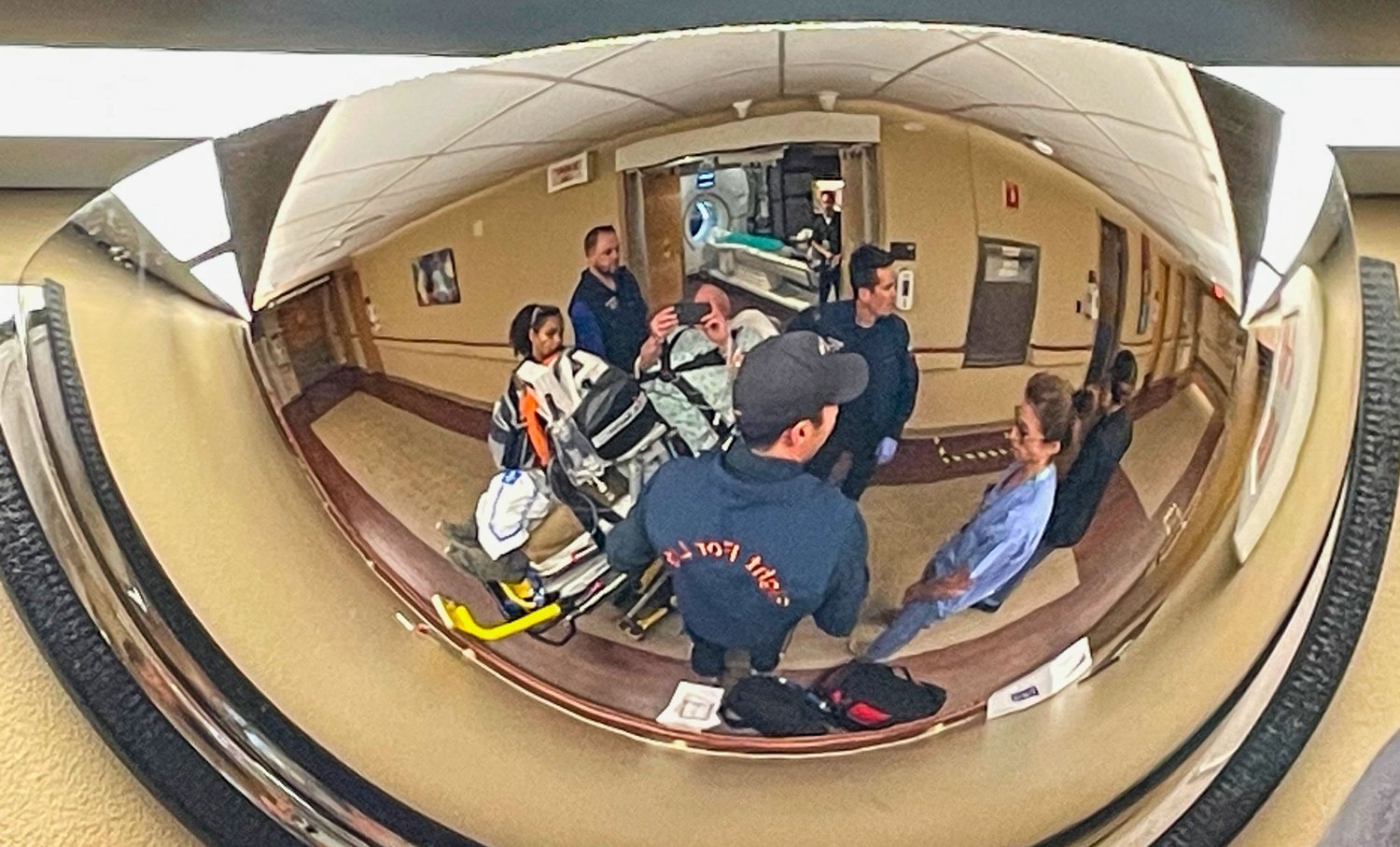
The author’s perspective
Dean Krakel (72)
Dean Krakel at the top of Red Lady chairlift at Mt. Crested Butte ski area on March 23, 2024. Photo by Julie Engel.
I love winter. I’ve skied all my adult life: alpine, cross country, touring and backcountry. So many beautiful places I have skied, from New Mexico to Montana. Skiing focuses my mind and gives me a good workout, if I work hard enough at it.
Skiing makes me forget about my problems and what’s going on in the world around me. I appreciate the silence and solitude, the joy I have experienced skiing with family and friends, the connection I have with the natural world.
On June 1, 2023 the snow in the mountains near my home in Almont, Colorado was still abundant and I planned to go check out the skiing on Monarch Pass that morning. But things didn’t go as planned. I got to see Monarch Pass that day but it was through the window of a Flight for Life enroute to Swedish Hospital in Denver. Three tiny pieces of a blood clot had traveled like shrapnel through the left side of my brain causing a stroke.
When I returned home a few weeks later my skis, skins attached, were still leaning against a wall by the front door. I wondered if I’d ever be able to use them again.
On January 31st, after 8 months of physical therapy I stepped tentatively into my bindings at the base of Crested Butte’s ski area. My fountain of anxieties and fears vanished on the first run. Making turns on the early morning corduroy, I was graceful and fast. The cold singed my cheeks, my skis made delightful snow music and the winter landscape’s beauty brought tears to my eyes.
Maybe I couldn’t drive, read a book, draw a picture or say the alphabet in the stroke’s aftermath but I could still ski. Skiing that day transformed me from stroke victim into stroke survivor. On skis I was me again.
Interviewing skiers and hearing their stories for this article was incredibly inspiring to me, as I hope reading about them has been for you. Skiing is something we can do for as long as it gives us happiness, for as long as our bodies will let us. Skiing is for keeps. It can challenge us and help us overcome challenges. It enriches our lives in innumerable ways and unites us in a friendly, helpful and loving global community that knows no age limits and exists wherever there is the magic of snow.
You can read more by Dean on his author page.



















